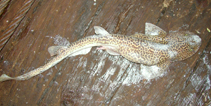| Family: |
Pentanchidae (Deepwater catsharks) |
| Max. size: |
69 cm TL (male/unsexed) |
| Environment: |
bathydemersal; marine; depth range - 1075 m |
| Distribution: |
Indian Ocean from Durban, kwaZulu-Natal, South Africa, southwards and westwards to Cape Agulhas; westward into the Atlantic Ocean; northwards to southeast of Lüderitz, Namibia. |
| Diagnosis: |
Dorsal spines (total): 0-0; Dorsal soft rays (total): 0-0; Anal spines: 0-0; Anal soft rays: 0-0. A broad-headed catshark with crowded dark brown spots on a yellowish background, producing a net-like pattern of light lines; underside white with small black pores; no labial furrows (Ref. 5578). Specimens less than 23 cm TL blackish with white side spots (Ref. 5578). |
| Biology: |
Found on the outer continental shelf and upper slope, on or near the bottom (Ref. 244). This species has been reported to prefer temperate to cool temperate waters, but may also be found in subtropical waters; apparently prefer 200-300 m depths on the west coast and 100-200 m depths on the south coast; and, a common by catch of demersal trawlers (Ref. 75585). Feeds mainly on pelagic bony fishes, also fish offal, hagfish eggs, crustaceans, and cephalopods (Ref. 5578). Oviparous (Ref. 50449). |
| IUCN Red List Status: |
Least Concern (LC); Date assessed: 01 August 2019 Ref. (130435)
|
| Threat to humans: |
harmless |
Source and more info: www.fishbase.org. For personal, classroom, and other internal use only. Not for publication.
